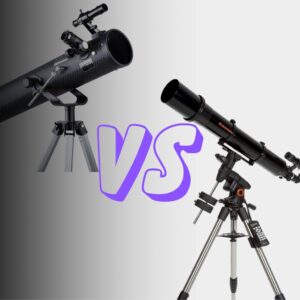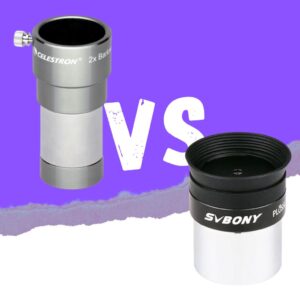This site contains affiliate links to products. I may receive a commission for purchases made through these links.
If you’re a stargazer like me, you’ll know the struggle of keeping celestial bodies in view. That’s where a Dobsonian telescope with tracking comes in handy. It’s a game-changer, providing a stable and easy-to-use platform for observing the universe’s wonders.
Dobsonian telescopes are known for their simplicity and affordability. But, when combined with tracking capabilities, they really shine. Tracking allows the telescope to automatically follow celestial objects as they move across the sky. It’s like having your personal guide to the cosmos.
So, whether you’re a seasoned astronomer or a newbie, a Dobsonian telescope with tracking is a worthy investment. It’s not just about viewing stars – it’s about immersing yourself in the cosmic world without losing sight of your target. Let’s explore more about this amazing piece of equipment.
What is a Dobsonian telescope?
Let’s delve into the world of Dobsonian Telescopes. Named after their inventor, John Dobson, Dobsonian telescopes have revolutionized the field of sky-gazing. Despite being a amateur astronomer, Dobson designed a telescope that embodies simplicity, efficiency, and cost-effectiveness.
So, what makes a Dobsonian telescope stand out? It’s their mount design that deserves a mention. Unlike standard tripod mounts, Dobsonian telescopes sport an altitude-azimuth or Alt-Az mount. You might wonder why this is so profound. This design allows for a back-and-forth, up-and-down movement, making it quick and easy for stargazers to align the telescope with the desired celestial body.
Also, their optical design – a Newtonian reflector type – is a plus point. Newtonian reflectors use a combo of mirrors to catch and reflect light, enabling clear, bright images of far-off space bodies. This feature, combined with the Dobsonian’s large aperture, means a novice astronomer can enjoy deep sky objects like galaxies and nebulae with exceptional clarity and detail.
When it comes to material, Dobsonian telescopes typically use plywood, particle board, or even Formica for their bases. It might not sound too high-tech, but these materials provide both sturdiness and lightweight traits – an ideal combo for any telescope. Plus, it keeps the end cost more affordable for us consumers.
In the following sections, we’ll explore how enhancing a Dobsonian telescope with tracking capability can elevate your stargazing game. Stay with me as we embark on this cosmic journey.
Benefits of using a Dobsonian telescope
Perhaps you’re considering the purchase of a Dobsonian telescope for your stargazing hobby. If so, you’ve made an excellent choice. Dobsonian telescopes come with several benefits that set them apart from typical end-market models.
A Dobsonian telescope is notably easy to use. Its unique Alt-Az mount design is a game-changer for beginners in astronomy, as it provides quick and easy alignment with celestial bodies. Unlike Equatorial mounts, there’s no guesswork. Point it at your desired object, and you’re good to go.
Next, we must mention the Dobsonian’s large aperture. This factor is fundamental as it determines the amount of light the telescope can collect. A larger aperture permits better views of faint celestial objects, such as galaxies and nebulae. Dobsonian telescopes typically offer larger apertures at affordable prices.
The simplicity of a Dobsonian telescope also extends to its construction. They’re crafted using sturdy, lightweight materials that contribute to their ruggedness and ease of use. Their robust bases provide the stability necessary to stably view deep space images. Moreover, the lightweight construction of Dobsonians allows you to easily transport and position the telescope where it’s most convenient for you.
Finally, affordability. In comparison to other telescope designs that offer similar apertures and capabilities, Dobsonians are a cost-effective choice. Despite their large size and high-quality views, these telescopes retain an accessible price point.
Couple a Dobsonian with tracking capabilities, and you elevate an already high-grade experience. You can indeed look forward to spending many pleasant evenings exploring the wonders of deep space with this combination. Let’s dive deeper into how tracking transforms your Dobsonian telescope experience in the next section.
Understanding tracking in telescopes
The magic of a stargazing experience often intensifies when our celestial buddies move across the sky. These shifting views, while undoubtedly captivating, may also bring a unique challenge: how to keep the objects within sight? Here’s where the concept of ‘tracking’ enters the telescope world.
Typically, most stars appear to move from east to west due to Earth’s rotation. It’s a slow but steady dance, making them glide across our field of vision when observed through a telescope. Without tracking, I constantly have to adjust the telescope manually—an activity that, over time, takes away from the awe and wonder of stargazing.
Enter the tracking mechanism—a feature that can keep celestial objects in line with your telescope’s field of view automatically. This feature tracks the sidereal rate—the rate at which objects move across the sky—and adjusts the telescope accordingly. No longer do you need to manually correct the telescope’s position. It’s a game-changer.
There are two primary types of tracking systems—Alt-Azimuth and Equatorial. While an equatorial mount tracks objects by pivoting the telescope around a single axis parallel to Earth’s axis of rotation, an Alt-Az mount, such as the one on a Dobsonian telescope, moves the device in two axes (horizontal and vertical) independently.
Dobsonian telescopes, known for their simple yet efficient design, traditionally do not come with a built-in tracking system. However, their straightforward design allows for easy enhancements with a tracking capability.
By enhancing a Dobsonian telescope with tracking capability, you’re essentially revitalizing an already stellar tool with an added dimension of convenience and precision. Stay tuned as we discuss how to enhance a Dobsonian telescope with tracking capability in our next segment.
Why choose a Dobsonian telescope with tracking?
Firstly, let’s delve into why you should opt for a Dobsonian telescope with tracking. To start, it’s about stability. Dobsonian telescopes, lovingly referred to as “Dobs”, are infamous for their superb stability. Having a tracking system significantly enhances this robustness, allowing for smooth, continuous tracking of celestial bodies.
Consider versatility. Not only are Dobsonian telescopes known for their stability, but they’re equally celebrated for their versatility. In comparison to other types of telescopes, Dobs are inherently user-friendly and excel in deep-sky viewing. Able to observe faint objects such as nebulae, galaxies, and star clusters, they offer unbridled access to the night sky’s beauty. Enhancing a Dob with a tracking system propels its functionality to the next level, resulting in an advanced stargazing tool.
Of course, we can’t skip the ease of use. Fitted with a tracking system, a Dobsonian telescope removes the need for constant manual adjustments. By automatically keeping celestial objects within its field of view, it alleviates the common annoyance of losing sight of your star or planet. This assists seasoned astronomers to execute long stargazing sessions smoothly and novice astronomers to explore the cosmos without aggravation.
Selecting Your Dobsonian Telescope with Tracking
Included in this article, you’ll find the essential factors to consider when choosing your Dobsonian telescope with a tracking module. Keep in mind the size, cost, material, brand, and user reviews. Look out for the section to help you make a wise, informed decision.
Personalizing a Dobsonian telescope with tracking capability not only simplifies the stargazing process but simultaneously enhances the experience, elevating a humble stargazing session to an encapsulating cosmic journey. This upgrade moves beyond convenience to a realm where every star, every planet, and every galaxy is within your reach, ready for you to explore and marvel at.
Remember – the sky’s the limit, but only if you let it be.
Features to consider when buying a Dobsonian telescope with tracking
To make the most out of your star-gazing sessions, it’s crucial to pay attention to certain features while purchasing a Dobsonian telescope with tracking. Let’s take a peek into some of these impactful attributes.
Aperture Size
First and foremost, consider the aperture size. It’s the diameter of the telescope’s main lens or mirror — a key factor in determining the object’s brightness and sharpness you can see. Bigger aperture sizes allow more light to enter, offering clearer views of distant celestial objects.
Tracking System
Effective tracking is another fundamental feature you shouldn’t overlook. A reliable tracking module reduces manual adjustments while observing moving objects in the sky. It keeps your telescope accurately aligned to your targeted celestial body, providing continuous viewing experience.
Mount Type
Since Dobsonian telescopes are known for their sturdy, yet simple base, ensure you pick one with a dependable mount. The mount should balance the telescope well enough to prevent tipping over or wobbling. Altazimuth mounts are a popular choice among Dobsonian users due to their straightforward and user-friendly design.
Ease of Use
An easy-to-use interface is an underrated virtue in a Dobsonian telescope with tracking. Look for models that come with comprehensive user manuals, simple assembly processes, and intuitive controls.
Material and Durability
The telescope’s material and overall build quality can affect both its longevity and usability. Opt for durable materials and robust construction. This entails an enduring device that withstands regular usage and weather elements.
Brand and User Reviews
A telescope is a significant investment. Hence, it’s wise to buy from trusted brands with positive reviews. User reviews provide first-hand insights about product performance and reliability. They can guide you towards a product that aligns with your personal requirements and preferences.
Each individual has unique priorities and preferences when it comes to telescopes. Assess these features, weigh your options, and choose a telescope that magnifies your passion for astronomy.
Conclusion
So there you have it. When it’s time to buy your Dobsonian telescope with tracking, don’t forget to weigh the features that matter the most to you. Whether it’s the aperture size, tracking system, mount type, or simply the brand’s reputation, your decision should reflect your personal needs and preferences. Remember, the right telescope isn’t necessarily the most expensive one or the one with the most features. It’s the one that will give you the best stargazing experience. So take your time, do your research, and choose wisely. Your future nights under the stars will thank you.
Frequently Asked Questions
What features should I consider when buying a Dobsonian telescope with tracking?
When purchasing a Dobsonian telescope with tracking, various features should be examined. Key considerations include aperture size, tracking system, type of mount, ease of use, the telescope’s material and durability, and the brand and user reviews.
How important is the aperture size in a Dobsonian telescope?
A telescope’s aperture size is crucial. It determines how much light the telescope can gather, influencing its ability to capture clear, detailed images of distant celestial bodies.
What is the role of the tracking system in a Dobsonian telescope?
A tracking system in a Dobsonian telescope allows the device to follow a celestial object’s movement in the sky automatically. This makes it easier for users to observe objects over extended periods.
Why should I consider the type of mount in a Dobsonian telescope?
Considering the mount type is significant because it impacts the telescope’s stability and ease of use. Stable mounts ensure clear and steady image views, especially during high magnification.
Why is ease of use important when selecting a Dobsonian telescope?
Ease of use is important when choosing a telescope, especially for beginners. A telescope that is easy to set up and operate enables the user to focus more on observing the stars rather than struggling with the equipment.
Why does the material and durability of the Dobsonian telescope matter?
The material and durability of the telescope are vital. A durable telescope made from robust materials will withstand incidental impacts and adverse weather conditions, ensuring longevity.
How should brand and user reviews influence my purchase decision?
Brand and user reviews provide first-hand experiences about the telescope’s performance and durability. They can offer valuable insights and aid in making an informed purchase decision.




